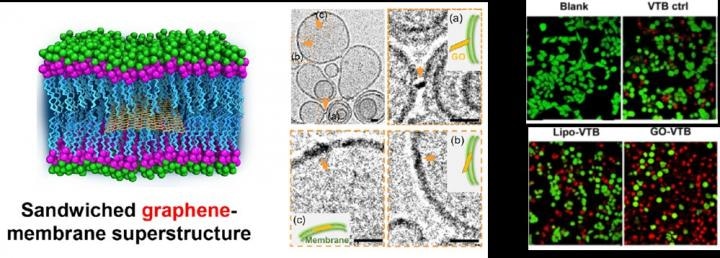Jun 10 2019
Scientists at the Institute of Process Engineering (IPE) of the Chinese Academy of Sciences and Tsinghua University (THU) have newly confirmed a sandwiched superstructure for graphene oxide (GO), which can transport inside the cell membranes.
 (Left): Graphic illustration: (middle) cryo-TEM experimental evidence and (right) superior drug delivery efficacy (GO-VTB) of the sandwiched graphene-membrane superstructure.(Image credit: Yue Hua and Chen Pengyu)
(Left): Graphic illustration: (middle) cryo-TEM experimental evidence and (right) superior drug delivery efficacy (GO-VTB) of the sandwiched graphene-membrane superstructure.(Image credit: Yue Hua and Chen Pengyu)
The finding, reported in Science Advances, has revealed a membrane-specific drug delivery mode, which could greatly enhance the effects of cytotoxicity on conventional drug carriers.
The nanoparticle transport at the bio-nano interfaces is necessary for biomedical applications and cellular responses. The interaction or diffusion of two-dimensional nanomaterials inside the cell membrane remains unknown, thus hampering their use in the biomedical field.
The sandwiched graphene membrane is a long-simulated superstructure but an unproved issue in vitro. We are excited to provide substantial experimental evidence and open an avenue for novel membrane-specific drug delivery.
Wei Wei, Professor, State Key Laboratory of Biochemical Engineering, Institute of Process Engineering
The sandwiched GO was imagined to be formed in a completely hydrated or native state, and a significant impact on cell fluidity, cell roughness, and membrane rigidity was also demonstrated.
Moreover, the sandwiched GO caused high drug entry and fast diffusion time within the membrane lipid layer and outperformed a typical liposome carrier in anticancer efficacy. For Wei, this feature is also very effective in delivering vaccine adjuvants (for example, membrane receptor ligands) for greater immune effect.
All the diffusion dynamics, cell interactions, and the high efficiency of membrane-specific drug delivery of sandwiched GO were reproduced by Prof. Yan Litang from THU.
According to the peer reviewers from Science Advances, “It is a very nice study of graphene-membrane superstructures. It discloses different transport regimes, the presence of pores and a number of other potentially interesting features related to these systems. Moreover, they demonstrate the applicability of GOs for drug delivery. Overall, the paper is very timely and tells a good story.”
The GO-based sandwiched superstructure provides huge design capabilities, allowing these evolving nanomaterials to find wide applications in the advanced fields of medical and biological science.